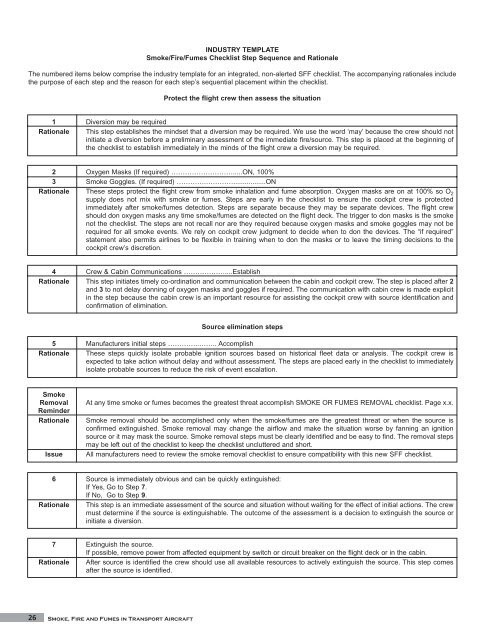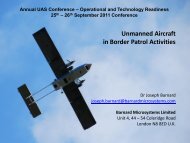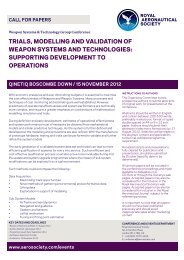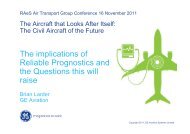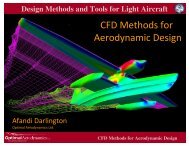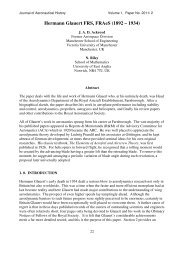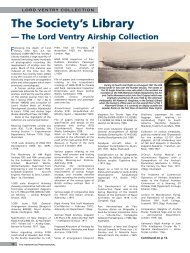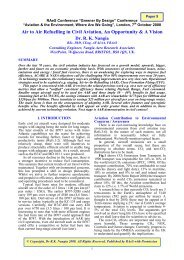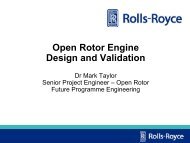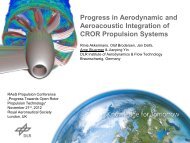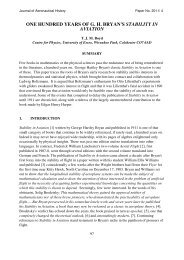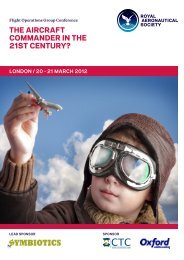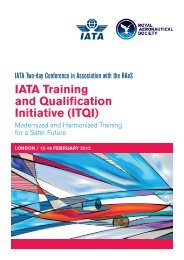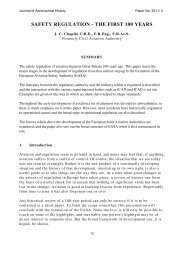Smoke, Fire and Fumes in Transport Aircraft - Royal Aeronautical ...
Smoke, Fire and Fumes in Transport Aircraft - Royal Aeronautical ...
Smoke, Fire and Fumes in Transport Aircraft - Royal Aeronautical ...
Create successful ePaper yourself
Turn your PDF publications into a flip-book with our unique Google optimized e-Paper software.
26<br />
<strong>Smoke</strong><br />
Removal At any time smoke or fumes becomes the greatest threat accomplish SMOKE OR FUMES REMOVAL checklist. Page x.x.<br />
Rem<strong>in</strong>der<br />
Rationale <strong>Smoke</strong> removal should be accomplished only when the smoke/fumes are the greatest threat or when the source is<br />
confirmed ext<strong>in</strong>guished. <strong>Smoke</strong> removal may change the airflow <strong>and</strong> make the situation worse by fann<strong>in</strong>g an ignition<br />
source or it may mask the source. <strong>Smoke</strong> removal steps must be clearly identified <strong>and</strong> be easy to f<strong>in</strong>d. The removal steps<br />
may be left out of the checklist to keep the checklist uncluttered <strong>and</strong> short.<br />
Issue All manufacturers need to review the smoke removal checklist to ensure compatibility with this new SFF checklist.<br />
6 Source is immediately obvious <strong>and</strong> can be quickly ext<strong>in</strong>guished:<br />
If Yes, Go to Step 7.<br />
If No, Go to Step 9.<br />
Rationale This step is an immediate assessment of the source <strong>and</strong> situation without wait<strong>in</strong>g for the effect of <strong>in</strong>itial actions. The crew<br />
must determ<strong>in</strong>e if the source is ext<strong>in</strong>guishable. The outcome of the assessment is a decision to ext<strong>in</strong>guish the source or<br />
<strong>in</strong>itiate a diversion.<br />
7 Ext<strong>in</strong>guish the source.<br />
If possible, remove power from affected equipment by switch or circuit breaker on the flight deck or <strong>in</strong> the cab<strong>in</strong>.<br />
Rationale After source is identified the crew should use all available resources to actively ext<strong>in</strong>guish the source. This step comes<br />
after the source is identified.<br />
<strong>Smoke</strong>, <strong>Fire</strong> <strong>and</strong> <strong>Fumes</strong> <strong>in</strong> <strong>Transport</strong> <strong>Aircraft</strong><br />
INDUSTRY TEMPLATE<br />
<strong>Smoke</strong>/<strong>Fire</strong>/<strong>Fumes</strong> Checklist Step Sequence <strong>and</strong> Rationale<br />
The numbered items below comprise the <strong>in</strong>dustry template for an <strong>in</strong>tegrated, non-alerted SFF checklist. The accompany<strong>in</strong>g rationales <strong>in</strong>clude<br />
the purpose of each step <strong>and</strong> the reason for each step’s sequential placement with<strong>in</strong> the checklist.<br />
Protect the flight crew then assess the situation<br />
1 Diversion may be required<br />
Rationale This step establishes the m<strong>in</strong>dset that a diversion may be required. We use the word ‘may’ because the crew should not<br />
<strong>in</strong>itiate a diversion before a prelim<strong>in</strong>ary assessment of the immediate fire/source. This step is placed at the beg<strong>in</strong>n<strong>in</strong>g of<br />
the checklist to establish immediately <strong>in</strong> the m<strong>in</strong>ds of the flight crew a diversion may be required.<br />
2 Oxygen Masks (If required) ……………………….....ON, 100%<br />
3 <strong>Smoke</strong> Goggles. (If required) ………….………….................ON<br />
Rationale These steps protect the flight crew from smoke <strong>in</strong>halation <strong>and</strong> fume absorption. Oxygen masks are on at 100% so O 2<br />
supply does not mix with smoke or fumes. Steps are early <strong>in</strong> the checklist to ensure the cockpit crew is protected<br />
immediately after smoke/fumes detection. Steps are separate because they may be separate devices. The flight crew<br />
should don oxygen masks any time smoke/fumes are detected on the flight deck. The trigger to don masks is the smoke<br />
not the checklist. The steps are not recall nor are they required because oxygen masks <strong>and</strong> smoke goggles may not be<br />
required for all smoke events. We rely on cockpit crew judgment to decide when to don the devices. The “if required”<br />
statement also permits airl<strong>in</strong>es to be flexible <strong>in</strong> tra<strong>in</strong><strong>in</strong>g when to don the masks or to leave the tim<strong>in</strong>g decisions to the<br />
cockpit crew’s discretion.<br />
4 Crew & Cab<strong>in</strong> Communications ………………....Establish<br />
Rationale This step <strong>in</strong>itiates timely co-ord<strong>in</strong>ation <strong>and</strong> communication between the cab<strong>in</strong> <strong>and</strong> cockpit crew. The step is placed after 2<br />
<strong>and</strong> 3 to not delay donn<strong>in</strong>g of oxygen masks <strong>and</strong> goggles if required. The communication with cab<strong>in</strong> crew is made explicit<br />
<strong>in</strong> the step because the cab<strong>in</strong> crew is an important resource for assist<strong>in</strong>g the cockpit crew with source identification <strong>and</strong><br />
confirmation of elim<strong>in</strong>ation.<br />
Source elim<strong>in</strong>ation steps<br />
5 Manufacturers <strong>in</strong>itial steps …………..…….. Accomplish<br />
Rationale These steps quickly isolate probable ignition sources based on historical fleet data or analysis. The cockpit crew is<br />
expected to take action without delay <strong>and</strong> without assessment. The steps are placed early <strong>in</strong> the checklist to immediately<br />
isolate probable sources to reduce the risk of event escalation.


